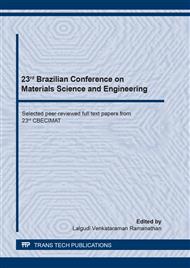p.461
p.466
p.471
p.477
p.483
p.489
p.494
p.500
p.506
Physical-Chemical and Thermal Characterization of Powder Eucalyptus Bark
Abstract:
Eucalyptus bark is an agroindustry residue generated in large quantities due to its physical-chemical characteristics. Several industries, such as the pulp and paper industry, the timber and derived industries, do the wood separation and commonly the bark is discarded in the field or sent to companies that consume them as an energy product. Although it is a material with a high energy content, even larger than the wood itself, due to its characteristics, some companies cannot consume this material without first processing it. This processing serves to change the geometry of the material, either by reducing the size of the fibers, that is to standardize a particle size, to facilitate the transport and internal logistics of the companies, until the arrival in the burners and / or boilers. Therefore, it is necessary to know some physical and chemical characteristics of the material before and after these changes. The purpose of this work was to characterize and compare the particulate matter with the processed material. It was carried out the immediate chemical analysis, the verification of the humidity and density, the calorific value of the materials and the thermal degradation in inert and oxidizing atmosphere. The results showed that there were beneficial changes in the characteristics of the materials, mainly in the thermal analyzes. These characteristics corroborate with the need to process the material in order to obtain better results in its applications.
Info:
Periodical:
Pages:
489-493
Citation:
Online since:
October 2020
Keywords:
Price:
Сopyright:
© 2020 Trans Tech Publications Ltd. All Rights Reserved
Share:
Citation:


